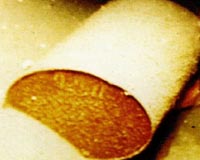 |
Corvallis OR (SPX) Apr 07, 2011 The long-standing conflicts over nuclear power and the risks of radiation exposure are nothing new - in fact, the debate over the damaged Fukushima Dai-Ichi plant in Japan are similar to arguments happening between scientists, governmental agencies and the public since 1945, according to an Oregon State University expert on the history of science. Historian Jacob Hamblin is the author of the 2008 book, "Poison in the Well: Radioactive Waste in the Oceans at the Dawn of the Nuclear Age." He specializes in the history of the Cold War era, with a particular focus on environmental sciences and the history of nuclear issues. "Science without history is just ignorance," Hamblin said. "Much of the current media debate about the safety of nuclear power and radiation exposure is an echo of conflicts going on since the dawn of the nuclear era." Hamblin said nuclear scientists have long decried public concerns over radiation exposure and the safety of nuclear power plants. Yet he says these same issues continue to cause conflict between anti-nuclear activists, scientists and pro-nuclear advocates. "In the 1950s, the response to the public was that it was irrational and that its fears about nuclear energy were based on emotion," Hamblin said. "I don't believe the public is irrational, but I do believe that the nuclear industry has failed to address some key issues, namely the issue of nuclear waste disposal and the risk of radiation exposure and contamination when something like Fukushima occurs." Hamblin's book tells the history of how policy decisions, scientific conflicts and public relations strategies were employed from the end of World War II through the blossoming environmental movement of the 1970s. By avoiding simplistic pro-or-con arguments, Hamblin said his goal was to research how and why decisions are made. "You can talk to scientists from a variety of backgrounds and hear five different true statements about nuclear power, and each of them will lead you to different conclusions," Hamblin said. "My point is not that nuclear power is bad, because I don't necessarily believe that, but that the public is torn on these issues because there are a variety of ways to interpret the science." In his book, Hamblin gives the example of tests being done by the U.S. military in the 1950s. Nuclear bombs were detonated over the Pacific Ocean, and oceanographers then studied how radioactivity circulated in the ocean and how much it was diluted. "Some oceanographers and radiation physicists tested the water and found that indeed, the ocean seemed to have diluted the radiation and there was little to no risk," Hamblin said. "Then another batch of scientists came out and they started testing the plants and fish and other sea life and they found higher levels of radiation absorption in those things that we eat." Hamblin's cautionary tale is that unanswered questions regarding nuclear energy need to be addressed with the public, and not in a dismissive way. In addition, he believes that there are lessons that can be learned from history. "Just over 40 years ago, people thought storing nuclear waste in ocean trenches was a good idea, until the discovery of plate tectonics," he said. "In the 1950s, safety levels of radiation exposure to reproductive organs were based on the assumption that most people were done having children by the age of 30." "My point is that the science is often informed by the culture and the politics and the technology of the time - and those things are always shifting. We need to consider what we want our energy legacy to be, and how we as a society plan to deal with the aftermath of whatever we choose."
Share This Article With Planet Earth
Related Links Oregon State University Nuclear Power News - Nuclear Science, Nuclear Technology Powering The World in the 21st Century at Energy-Daily.com
 Addressing The Nuclear Waste Issue
Addressing The Nuclear Waste IssueSeattle WA (SPX) Apr 06, 2011 Researchers from Northwestern University and Argonne National Laboratory have an enhanced understanding of a common freshwater alga and its remarkable ability to remove strontium from water. Insight into this mechanism ultimately could help scientists design methods to remove radioactive strontium from existing nuclear waste. Strontium 90, a major waste component, is one of the more danger ... read more |
|
| The content herein, unless otherwise known to be public domain, are Copyright 1995-2010 - SpaceDaily. AFP and UPI Wire Stories are copyright Agence France-Presse and United Press International. ESA Portal Reports are copyright European Space Agency. All NASA sourced material is public domain. Additional copyrights may apply in whole or part to other bona fide parties. Advertising does not imply endorsement,agreement or approval of any opinions, statements or information provided by SpaceDaily on any Web page published or hosted by SpaceDaily. Privacy Statement |